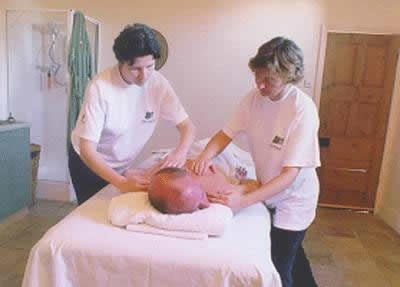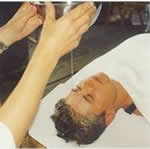Positive Health Online
Your Country

Panchakarma and Ayurvedic Massage
by Dr Kanu Patel and Pauline Barron(more info)
listed in ayurveda, originally published in issue 36 - January 1999
Panchakarma
Panchakarma is the ancient system of Ayurvedic rejuvenation therapies designed to facilitate the removal of deep rooted stresses and impurities in the physiology. It is recommended on a seasonal basis to maintain and promote well being in healthy people, and when needed, to restore balance in those suffering illness.
Our bodies are governed by their own unique rhythms and the rhythms of the environment such as weather patterns and seasonal changes. They also respond to what we put into them, and the situations and circumstances in which we live and work.

A patient receiving Ayurvedic treatment
Toxicity can come from our food, our relationships, our environment, even from our own thought patterns. Over time, possibly many years, unless we consciously work to lessen those experiences there is a build up of toxicity at all levels, physical, mental, emotional and spiritual.
Panchakarma is the process by which we can purify and lessen the degenerating influences of those experiences and toxic materials. It has to be said though that receiving or undergoing those therapies or treatments will be more successful and effective if consideration and thought is given to one's life style generally.
Our bodies have natural ways for removing toxins and Panchakarma treatments enhance its ability to do so. Some of the toxins accumulated in the body are water soluble and so when we are advised to drink lots of water this will keep cells hydrated and will provide the medium (water) for easy removal of water soluble toxins via kidneys (urine) and skin (perspiration). However, some toxins need an oily based medium to break them down so that they can move to the gastrointestinal tract and the skin to be eliminated.
Panchakarma works to provide this by using oils to suit a specific body type. By removing those toxins it allows the body to come into balance thus encouraging the body's own rejuvenating and healing ability to do the rest.
Panchakarma therapies consist of a variety of soothing and nourishing procedures aimed at restoring balance and harmony in the body.
Panchakarma means five actions. Traditionally a few days of Panchakarma and Ayurvedic therapies are recommended at the change of the season. This helps to eliminate the accumulation of a specific dosha.
The Body Doshas
Doshas are three vital energies that we call body types. Each dosha is a combination of two of the five great elements. Fire, water, earth, space and air. Everything according to Ayurveda is composed of these five great elements. They are everywhere and all things. They are constantly changing and interacting. A change in one of the elements affects all the others. The three doshas (body types) are: Vata, governed by space and air; Pitta governed by fire and water; Kapha governed by water and earth. Vata is the principle of movement. Pitta is the principle of transformation. Kapha the principle of structure, cohesion and lubrication. For more information on the Doshas and basic information on Ayurveda we recommend The Wisdom of Healing by David Simon, Perfect Health by Deepak Chopra, and The Book of Ayurveda by Judith Morrison.
In order that the five actions are performed correctly it is vital that a qualified Ayurvedic doctor gives the treatment. "An inexperienced professional can do more harm than good."
Poorva Karma
Poorva Karma, Preparatory Procedures, is designed to prepare the body for elimination of imbalances. It is in two parts Snehana or oleation and Swedna, heat treatment which is also used as an Ayurvedic massage treatment. Ayurveda says pure herbalised oils are able to permeate the cells and tissues and encourage the release of stored toxins.
There are many different herbal oil blends used for Poorva Karma. It is an art and science in itself to be able to prepare and apply them for individual needs. Another good reason for a qualified Ayurvedic doctor to perform the treatment.
Vaman
Carefully controlled vomiting. It is traditionally used to clear impurities in the stomach and excess in Kapha doshas, such as asthma, bronchitis, sinus congestion. The stomach is a major site for Kapha in the physiology and cleansing of this area as it reduces ama (toxins).
Virechan
Which means purgation. Using laxatives to clear out impurities from the small intestine, a major site for Pitta and, therefore, an effective treatment for removing ama that is associated with Pitta accumulation.
It is not recommended that laxatives are taken on a regular basis as they can create laziness in elimination.
Basti
The administration of herbalised enemas to cleanse and establish the correct function of the large intestines is ideal for excess of Vata associated ama.
Basti is different from enemas and purgation in that it does not deplete the system of digestive juices and can be used to nourish the system as well as purifying it.
Basti preserves the body's vitality and prevents an imbalance (a Vata aggravation). Due to emptiness in the organs care should be taken when eating – small meals of solid food before a basti and light meals of hot substances such as Mung Dal soup after the procedure. Again basti given to someone without proper preparation can aggravate the doshas and fail to eliminate ama from the patient, and sometimes cause pain and weakness.
Nasya
Application of herbalised substances through the nasal passages. This helps to clear impurities from the head. To begin with vigorous head/neck massage, and then herbalised oil gently introduced to each nostril. This helps chronic sinus congestion and rhinitis. Conditions such as anxiety, insomnia and headaches can also be relieved by he appropriate application of a Nasya.
Rakta Mokshana
The blood cleaning therapy. Historically this has involved the removal of small quantities of blood. Now the principles of this purification procedure are used in natural herbal formulas.
According to Ayurveda, blood letting can be done to all parts of the body according to our needs. However, Rakta is rarely used now in the West.
Abhyanga Massage
This is a unique herbalised warm oil massage that covers the body head to toe. It is administered by two therapists in synchronicity. The abhyanga is a process of complete oleation. Oil is systematically worked over the body and into the skin so that it is absorbed through the pores of the skin. The oil works its way in to the cells of the body by loosening toxins and purifying.
The oils are prepared individually with herbs to enhance their therapeutic effects. These oils promote secretions, penetrate to the deepest levels and while doing so will encourage:-
• The tissues to loosen accumulated toxins.
• Movement of toxins to the gastrointestinal tract and towards the surface (the skin) so they are eliminated.
• Movement of obstructions in energy channels and tissues.
• Lubrication and protection of tissues during this process.
• Nourishment and relaxation that enhances healing.
Vishesh Massage
This is similar to Abhyanga providing complete oleation as before. In Vishesh the strokes of the massage are firmer, deeper and heavier so that tension is relieved and the oils can penetrate the tissues more easily.
Shirodhara
In this treatment soothing warm oil is poured in a gentle stream on to the forehead. This is profoundly relaxing as it works to calm and pacify the central nervous system, stilling the mind and senses. This allows stress to be relaxed and so enhance natural healing. Duration of the treatment is about 20 minutes, and it can bring clarity of mind and comprehension.

Swedana
This is herbalised steam therapy. The heat of the steam helps to relieve tension and allows toxins that have been loosened beneath the skin to be "sweated out".
Pizzichilli
This is the luxurious treatment in which two therapists pour warm herbalised oils over the body while performing a gently soothing massage. This treatment is profoundly relaxing and deeply purifying.
Shiro-Abhyanga-Nasya
This is a thorough head, face and neck massage followed by herbalised steam to face, heat packs and herbal drops to nasal passages to clear congestion and improve mental clarity. Oiling the nasal passages helps to promote secretions that remove toxins, provides nourishment to tissues and also has a soothing and calming effect.
Other treatments include:-
Herbal Dusting
This uses specific herbs being rubbed into the body after any abhyanga or vishes. These are left on the body for 15-20 minutes, then removed using hot towel wraps.
Marma Therapy
This uses essential oils and light massage over specific points (marmas) on the body. This promotes balance at more subtle levels of mind and body.
Where can you receive Panchakarma and Ayurvedic Massage?
The Practice offers Panchakarma treatments with Doctor Kanu Patel (BSAM)
The Practice is a centre offering a range of educational programmes and a variety of healing therapies such as Panchakarma cleansing programmes and Ayurvedic Massage. We also offer short retreats (one night to seven) focusing on every aspect of health and well-being. We also offer educational programmes such as Primordial Sound Meditation, Creating Health course which is a five step exploration of mind and body medicine created by Deepak Chopra M.D. and David Simon M.D. and is designed for people who are interested in understanding the concepts of Ayurveda to help create health and harmony in their daily lives.
Comments:
-
No Article Comments available